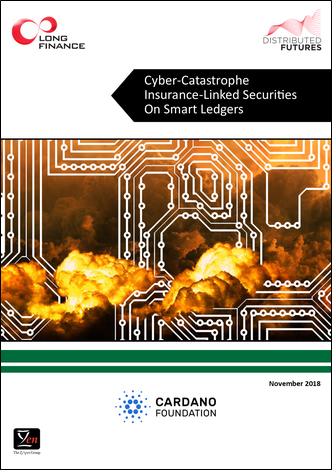Authors
Sam Carter and Professor Michael Mainelli
Sponsored by
- Cardano Foundation
Published by
Long Finance (November 2018), 75 pages.
Share on social media:




Cyber-Catastrophe Insurance-Linked Securities On Smart Ledgers
One of the strategies which the insurance industry has used to deal with the risk of natural catastrophes has been to transfer some catastrophe risk on to the financial markets. Omnipresent, networked computer systems change the landscape of cyber-catastrophe. Linking together machines around the world might have made the world a smaller place, but it has also made it more susceptible to the possible effects of a single disastrous event. For that reason, it is imperative that the insurance industry adapts the ways it manages cyber-catastrophe risk.
This report describes how cyber risk can be transferred to the capital markets in ways similar to, say, hurricane risk. With the help of Smart Ledgers, insurers and reinsurers can be certain that their clients are covered for anything.
The research was led by Sam Carter, Financial Sector Researcher, under the direction of Professor Michael Mainelli, Executive Chairman of Z/Yen Group, and explores the following:
- How did we get here? A history of insurance and catastrophe
- What are insurance-linked securities and how are they applied?
- Can we define cyber risk, and how well does the current insurance market cater for it?
- Cyber-catastrophe - a looming problem
- A suggested architecture: polling, bespoke indices, and Smart Ledgers
- Further applications: reporting, regulation, data anonymisation, indices, and alerts
The core work isn’t the reports so much as the demonstration software we completed where we now provide the ‘triggers’ and indices needed for an ILS. The software is implemented on a smart ledger as well as a central database.
- http://cyber-cat-ils.longfinance.net/ shows you a live cyber index as well as a demonstration of how the polling 'triggers' a live ILS
The smart ledger approach provides greater independence for the trigger, and a significant, additional, cyber defence. Armed with this research, Z/Yen, would be very interested in taking cyber catastrophe ILS development forward with any brokers, underwriters, investment banks, or rating agencies.




